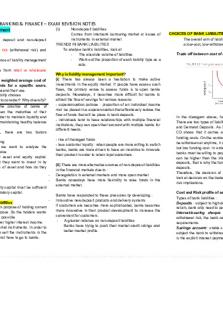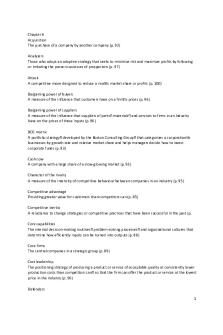Fin Alg Exam Notes - for revision PDF

| Title | Fin Alg Exam Notes - for revision |
|---|---|
| Course | Mathematics and Applications 2 |
| Institution | Australian National University |
| Pages | 1 |
| File Size | 57.8 KB |
| File Type | |
| Total Downloads | 49 |
| Total Views | 159 |
Summary
for revision...
Description
V is a finite dimensional vector space with bases B = {b1 , · · · bn } and C = {c1 , · · · cn }. W is a finite dimensional vector space with basis D = {d1 , · · · dn }. u and v are vectors in V . ci is a scalar. Definition 1. The vectors {u1 , · · · , um } are linearly independent if
c1 u1 + · · · + cm um = 0 implies c1 = · · · = cm = 0.
Definition 2. A subset S of V is a subspace if for all u, v in S and all scalars c, the following hold: u + v is in S; cu is in S; and 0 is in S . Coordinates: If v = c1 b1 + · · · + cn bn , the coordinate mapping sends v to the vector [v]B in Rn : c1 | | [v]B = ... [x]C = P [x]B = b1 C . . . bn C [x]B C←B | | cn
An n × n matrix M is diagonalisable if there is a basis for Rn consisting of eigenvectors of M . Equivalently, M is diagonalisable if there is an invertible matrix P and a diagonal matrix D such that M = P DP −1. Definition 3. A function T : V → W is a linear transformation if for all u, v in V and all scalars c, T (u + v) = T (u) + T (v) and T (cu) = cT (u). Given a linear transformation T : V → W and a choice of basis B for V and basis D for W , there is a unique matrix M that represents the transformation in the following sense: | | [T (x)]D = M [x]B = T (b1 ) D . . . T (bn ) D [x]B | | The characteristic polynomial of a square matrix M is det(M − λI). The roots of the characteristic polynomial are the eigenvalues of M, and for each root λi , the λi -eigenspace is Nul(M − λi I). √ 1 (−b ± 2 2 b − 4ac). Quadratic Formula: The roots of ax + bx + c = 0 are 2a Theorem 4 (Rank-Nullity Theorem). If T : V → W is a linear transformation, dim(ker T ) + dim(range T ) = dim(V ).
If x, y are vectors in Rn , then the vector projection of x onto y satisfies x·y projy x = y and (x − projy x) · y = 0 y·y
Theorem 5. Let {v1 , . . . , vk} be an orthogonal basis for a subspace W of Rn , and let w ∈ W . If w · vi . w = c1 v1 + · · · + ck vk , then ci = vi · vi
Definition 6. An orthogonal matrix is a square matrix whose columns are an orthogonal set of unit vectors. If U is an orthogonal matrix, then U T = U −1 . Gram-Schmidt Process: Given a set of vectors {x1 , . . . , xn }, define vi = xi − projv1 xi − · · · − projvi−1 xi . Then {v1 , . . . , vn } is an orthogonal set of vectors and Span{v1 , . . . , vk} = Span{x1 , . . . , xk} for all 1 ≤ k ≤ n. QR Decomposition: If A is an m × n matrix with linearly independent columns, then the GramSchmidt process allows us to factor A = QR where Q is an m × n matrix with orthonormal columns and R is an upper triangular matrrix with positive diagonal entries....
Similar Free PDFs

Revision Ch .11 Alg - .....
- 4 Pages

Homeostasis Revision for exam
- 11 Pages

Exam revision notes - useful
- 20 Pages

EIM-Exam-Revision-Notes
- 22 Pages

Exam Revision Notes
- 6 Pages

Revision wills - Exam notes
- 17 Pages

FIN 430 Notes Final Exam
- 4 Pages

Revision exercise for final exam
- 5 Pages

EXAM Revision FOR Mixed Reality
- 5 Pages

HAP Final Exam Revision Notes
- 64 Pages
Popular Institutions
- Tinajero National High School - Annex
- Politeknik Caltex Riau
- Yokohama City University
- SGT University
- University of Al-Qadisiyah
- Divine Word College of Vigan
- Techniek College Rotterdam
- Universidade de Santiago
- Universiti Teknologi MARA Cawangan Johor Kampus Pasir Gudang
- Poltekkes Kemenkes Yogyakarta
- Baguio City National High School
- Colegio san marcos
- preparatoria uno
- Centro de Bachillerato Tecnológico Industrial y de Servicios No. 107
- Dalian Maritime University
- Quang Trung Secondary School
- Colegio Tecnológico en Informática
- Corporación Regional de Educación Superior
- Grupo CEDVA
- Dar Al Uloom University
- Centro de Estudios Preuniversitarios de la Universidad Nacional de Ingeniería
- 上智大学
- Aakash International School, Nuna Majara
- San Felipe Neri Catholic School
- Kang Chiao International School - New Taipei City
- Misamis Occidental National High School
- Institución Educativa Escuela Normal Juan Ladrilleros
- Kolehiyo ng Pantukan
- Batanes State College
- Instituto Continental
- Sekolah Menengah Kejuruan Kesehatan Kaltara (Tarakan)
- Colegio de La Inmaculada Concepcion - Cebu





